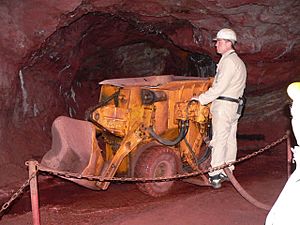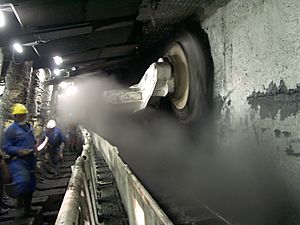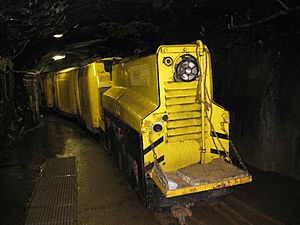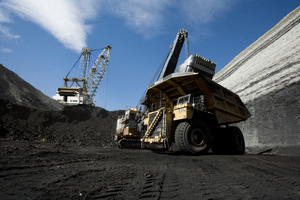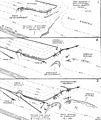Mining facts for kids
Mining is the process of digging valuable materials out of the ground. Any material that cannot be grown, like plants, must be mined. Taking these things from the ground is called extraction. Mining can include taking out metals and minerals, such as coal, diamonds, gold, silver, platinum, copper, tin, and iron. Mining also brings up other important things like oil and natural gas.
Some mining is done by scraping away the soil from the top of the ground. This is called surface mining. Other mining goes deep underground into a mine shaft. This is known as underground mining. Some mining, like for gold, is done in different ways. Gold can be found by searching in the bed of a river or stream to remove small pieces of gold. This is called panning or placer mining.
A worker in a mine is called a miner. Underground mining is a dangerous job. Many mines have accidents. Sadly, hundreds of miners die every year from accidents, mostly in poorer countries. Safety rules and special safety equipment are used to try and protect miners. Underground coal mining is especially dangerous because coal can release poisonous and explosive gases.
Some towns are called mining towns. People live there because they can earn money as miners or by providing services for miners.
Contents
Mining Methods
Mining methods are generally split into two main types: surface mining and underground mining. Today, surface mining is much more common. For example, in the United States, it produces most minerals (not including oil and natural gas).
The materials miners look for are in two main groups: placer deposits and lode deposits. Placer deposits are valuable minerals found in river gravels, beach sands, and other loose materials. Lode deposits are where valuable minerals are found in veins, layers, or small pieces spread throughout solid rock. Both types of deposits can be mined using surface or underground methods.
Some mining, including for rare earth elements and uranium, uses less common methods like in-situ leaching. This technique doesn't involve digging at the surface or underground. Instead, it uses liquids to dissolve the minerals where they are. This works for minerals that can dissolve in water, like potash or salt. Some minerals, like copper and uranium oxide, need acid or other solutions to dissolve.
Surface Mining
Surface mining involves removing (stripping) plants, dirt, and sometimes layers of rock from the top of the ground to reach valuable minerals buried below. Types of surface mining include:
- Open-pit mining: This is when materials are taken from a large open hole in the ground.
- Quarrying: This is like open-pit mining but is used specifically for sand, stone, and clay.
- Strip mining: This involves removing long strips of surface layers to uncover the minerals or coal seams underneath.
- Mountaintop removal: This is often used for coal mining. It means taking off the top of a mountain to get to the mineral deposits deep inside.
Most placer deposits are mined using surface methods because they are not buried very deep. There's also landfill mining, which means digging up old landfills to find and process materials. This can help deal with long-term pollution from landfills.
Underground Mining
Underground mining means digging tunnels or shafts into the earth to reach buried minerals. The minerals, after being processed, and the waste rock are brought to the surface through these tunnels and shafts. Underground mining can be grouped by how miners get into the mine, how they take out the minerals, or the specific way they reach the mineral deposit.
- Drift mining uses horizontal tunnels to get in.
- Slope mining uses tunnels that go down at an angle.
- Shaft mining uses straight-down vertical shafts.
Mining in very hard rock and softer rock needs different methods. Other ways of underground mining include:
- Shrinkage stope mining: Mining upwards to create a sloped underground room.
- Longwall mining: Grinding a long surface of minerals underground.
- Room and pillar mining: Taking minerals from rooms while leaving pillars of rock to hold up the roof. This often leads to retreat mining, where the supporting pillars are removed as miners leave, letting the room cave in and loosening more minerals.
Other underground mining methods include hard rock mining, bore hole mining, drift and fill mining, long hole slope mining, sub level caving, and block caving.
Highwall Mining
Highwall mining is another type of surface mining that developed from auger mining. In highwall mining, a special machine called a continuous miner digs into the coal seam. This machine is pushed forward by a hydraulic system. It cuts the entire height of the coal seam. As it digs, it pushes forward about 6 meters (19.72 feet) at a time. Then, a long rectangular pipe (called a Pushbeam) is added to the machine. This system can dig almost 300 meters (1,000 feet) into the coal seam.
Some highwall mining systems use special augers inside the Pushbeam. These augers prevent the mined coal from getting mixed with rock. Miners use video cameras or other sensors to see ahead. This helps them guide the machine and keep it within the coal seam. Highwall mining can produce huge amounts of coal in areas with narrow benches, previously mined spots, or steep seams. It can also manage water and gas inside the mine.
Mining Machines

Very large machines are used in mining. They help explore and prepare sites, remove dirt from the top, break and remove rocks, process the minerals, and clean up the land after the mine closes. Bulldozers, drills, explosives, and large trucks are all needed for digging.
For placer mining, loose gravel is put into machines with a hopper and a shaking screen. This separates the valuable minerals from the waste gravel. The minerals are then collected using sluices or jigs.
Large drills are used to dig shafts, create underground rooms, and get samples for testing. Trams are used to move miners, minerals, and waste. Lifts carry miners in and out of mines. They also move rock and minerals out, and machinery in and out, of underground mines. Huge trucks, shovels, and cranes are used in surface mining to move large amounts of dirt and minerals. Processing plants use big crushers, mills, and other equipment to get the desired metals and compounds from the mined material.
Images for kids
-
Surface coal mining
-
Ancient Roman development of the Dolaucothi Gold Mines, Wales
-
Agricola, author of De Re Metallica
-
Lead mining in the upper Mississippi River region of the U.S., 1865
-
A hose sprays water into a placer mine in Fairplay, Colorado, to assist with mining operations in the early 1900s. (Park County Local History Digital Archive)
-
The Särkijärvi pit of the apatite mine in Siilinjärvi, Finland
-
The Bingham Canyon Mine of Rio Tinto's subsidiary, Kennecott Utah Copper.
-
A coal miner in West Virginia spraying rockdust to reduce the combustible fraction of coal dust in the air.
-
Breaker boys: child workers who broke down coal at a mine in South Pittston, Pennsylvania, United States in the early 20th century
-
Macro of native copper about 4 cm (1 1/2 inches) in size.
-
A metal recycling plant in South Carolina that has been abandoned for years.
See also
 In Spanish: Minería para niños
In Spanish: Minería para niños


